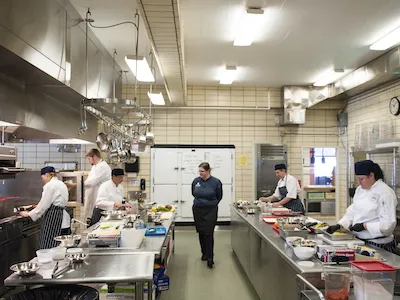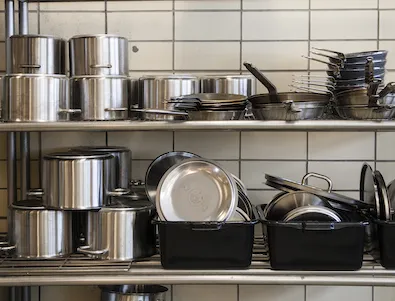Embarking on a culinary journey is an exciting prospect, and for those drawn to stunning natural landscapes and a burgeoning local food scene, looking into Culinary Schools In Montana offers a unique pathway. As someone deeply invested in the intricate connections between place, culture, and cuisine, I find Montana’s evolving food landscape particularly compelling. It’s a state where rugged traditions meet modern culinary innovation, creating fertile ground for aspiring chefs and hospitality professionals.
Montana’s culinary identity is intrinsically linked to its environment and history. Think of bison, trout, huckleberries, and locally raised beef, all staples that influence restaurant menus and local cooking. Studying here means connecting with this rich larder and the producers behind it. This blend of rustic charm and growing sophistication provides a dynamic learning environment, setting the stage for exploring various career paths within the hospitality industry.
Why Montana? The Appeal of the Big Sky State for Culinary Arts
Studying culinary arts in Montana offers more than just classroom instruction; it provides an immersive experience in a state that values local sourcing and authentic flavors. The “farm-to-table” movement isn’t a trend here; it’s a way of life deeply rooted in the state’s agricultural heritage. Culinary schools in the state often integrate this philosophy into their curriculum, offering students hands-on experience with regional ingredients and seasonal cooking.
Furthermore, Montana’s strong tourism industry, fueled by iconic destinations like Yellowstone and Glacier National Parks, creates ample opportunities for culinary graduates. High-end lodges, guest ranches, bustling restaurants in cities like Bozeman, Missoula, and Billings, and unique food ventures all require skilled professionals. Choosing to study here means positioning yourself within a growing market with diverse employment possibilities, from fine dining to casual eateries and catering.
Navigating Your Options: Choosing the Right Culinary School In Montana
When considering Culinary Schools In Montana, prospective students will find options ranging from community colleges offering associate degrees to technical programs and possibly certificate courses. Each type of institution offers a different focus, duration, and learning style. It’s crucial to assess your personal goals, desired career path, and learning preferences to find the best fit.
Key factors to evaluate include the curriculum (does it emphasize classic techniques, regional cuisine, business aspects?), the amount of hands-on training provided, the experience and credentials of the faculty, industry connections for internships and job placement, the cost of tuition, and the location itself. Researching these aspects will help you narrow down your choices and make an informed decision about your culinary education journey.
Featured Program: Gallatin College’s Culinary Arts AAS Degree
One prominent option among Culinary Schools In Montana is the Associate of Applied Science (AAS) degree in Culinary Arts offered by Gallatin College, part of Montana State University in Bozeman. This 65-credit program is designed to provide students with relevant coursework and significant experiential education, preparing them for a wide array of roles within the culinary and foodservice industries.
Discover the Best of What to Do in Downtown Denver – Your Ultimate Guide
Discover the Best Brunch in Denver – A Local’s Guide
Top 10 Places to Visit in Nevada with Family for an Epic Trip
What distinguishes the Gallatin College program is its intentional alignment with Montana’s specific food culture and robust tourism sector. While grounded in traditional culinary arts principles, the curriculum incorporates elements relevant to the regional context. Graduates from this program are equipped with skills applicable locally, throughout the United States, and potentially internationally.
The program boasts several unique features that enhance the learning experience. Small class sizes and a low student-to-chef ratio ensure personalized, hands-on instruction. Its convenient location on the Montana State University campus in Bozeman provides access to university resources while maintaining a focused college environment. There’s also a strong emphasis on connecting students with the local tourism and food services industries, facilitating valuable internship and job placement opportunities upon graduation.
Affordability is another key aspect, with significantly lower tuition costs for in-state students over the two-year program. The faculty are experienced professionals with decades of industry practice. For example, Program Director Chef Mike Dean brings over 20 years of experience as a Certified Executive Chef with the American Culinary Federation (ACF), having held significant roles with Xanterra Parks and Resorts in Yellowstone National Park. His expertise in areas like menu writing, recipe development, training, and kitchen management provides students with insights from a seasoned industry leader.
Graduates are well-prepared for diverse roles such as cook, Chef de Partie, Sous Chef, Executive Chef, or Pastry Chef. The program also supports entrepreneurial aspirations, whether starting an independent restaurant, bake shop, food truck, or catering business. It can serve as a pathway to becoming an ACF Certified Culinarian or even transferring into Montana State University’s Hospitality Management Bachelor’s degree program for those wishing to broaden their education beyond the kitchen.
It’s worth noting that due to the program’s quality and reputation, interest is high, and openings can be limited. Prospective students are encouraged to apply early and contact Gallatin College directly for the most current information on admissions and program details.
 Culinary classroom at Gallatin College, one of the leading Culinary Schools In Montana
Culinary classroom at Gallatin College, one of the leading Culinary Schools In Montana
Located in Hannon Hall on the MSU campus, the Hospitality Management & Culinary Arts facilities provide a practical learning environment. This physical space allows students to apply theoretical knowledge in a hands-on setting, simulating real-world kitchen and service scenarios. The integrated learning environment is crucial for developing the practical skills necessary for a successful culinary career.
Gallatin College also provides resources beyond the core curriculum. Information requests are easily facilitated, allowing interested individuals to learn more about academics and student life before applying. This accessibility helps potential students make informed decisions about their enrollment.
 Students in a classroom setting at Gallatin College, an option among Culinary Schools In Montana
Students in a classroom setting at Gallatin College, an option among Culinary Schools In Montana
Financial support is often a critical factor for students pursuing higher education. Gallatin College offers numerous scholarships specifically for currently enrolled students declared in a Gallatin College major who can demonstrate financial need. These opportunities help make culinary education more accessible to a wider range of students.
 Close-up of pots and pans in a professional kitchen setting, typical of Culinary Schools In Montana
Close-up of pots and pans in a professional kitchen setting, typical of Culinary Schools In Montana
Reviewing the course descriptions provides a clear outline of the required classes, giving prospective students a detailed look at the curriculum. This transparency allows applicants to understand the breadth and depth of the training they will receive, from fundamental cooking techniques to advanced culinary concepts and potentially aspects of kitchen management and hospitality. Understanding the course load and content is a vital step in the application process for any culinary program.
Beyond the Classroom: Experiencing Montana’s Food Scene
Studying at Culinary Schools In Montana isn’t confined to lecture halls and practical kitchens. The state itself serves as an extension of the classroom. Students have the opportunity to engage directly with Montana’s vibrant food ecosystem. This includes visiting local farms, exploring bustling farmers’ markets to understand seasonal availability and regional produce, and participating in local food festivals.
Internships offered through programs like Gallatin College provide invaluable real-world experience in diverse settings, from restaurants in Bozeman’s thriving downtown to resorts nestled in the mountains. These experiences allow students to apply learned skills, build professional networks, and gain exposure to the demands and rewards of the industry in a genuine Montana context. It’s a chance to live and breathe the local culture and cuisine.
Career Paths for Culinary Graduates in Montana
Graduates from Culinary Schools In Montana are well-positioned for various roles within the state’s growing hospitality sector. The traditional restaurant kitchen offers roles from line cook to executive chef. However, opportunities extend far beyond. Montana’s lodges and resorts, particularly those near national parks and ski areas, employ a large number of culinary professionals, often in high-volume or fine-dining settings.
The rise of food trucks and catering businesses in Montana’s urban centers and popular tourist destinations also presents exciting entrepreneurial and employment avenues. Additionally, institutions like hospitals, schools, and assisted living facilities require skilled food service staff. Studying in Montana provides insights specific to this market, preparing graduates for the unique challenges and opportunities found within the state’s diverse culinary landscape.
Practicalities: Cost and Admissions
Investing in a culinary education is a significant decision, and understanding the costs involved is essential. As highlighted by the Gallatin College example, tuition rates can vary significantly between in-state and out-of-state students. Prospective students should research the full cost of attendance, including fees, books, supplies (like knife kits and uniforms), and living expenses, for any program they consider.
Financial aid options, including scholarships, grants, and loans, are available at many institutions and should be explored thoroughly. The admissions process typically involves submitting applications, transcripts, and sometimes letters of recommendation or interviews. Given the popularity of certain programs, particularly specialized Culinary Schools In Montana, applying early is often recommended to secure a spot.
Frequently Asked Questions (FAQ)
What types of culinary programs are available in Montana?
Montana offers various culinary education options, including Associate of Applied Science (AAS) degrees and certificate programs at community colleges and technical schools. These programs vary in length and focus.
How long does it take to complete a culinary program in Montana?
Program lengths vary. An AAS degree like the one at Gallatin College typically takes two years of full-time study. Certificate programs may be shorter, ranging from a few months to a year.
What kind of job opportunities are available for culinary graduates in Montana?
Graduates can find work in restaurants, hotels, resorts, lodges, catering companies, food trucks, institutional food service, and even start their own food businesses within Montana’s growing hospitality and tourism industries.
Are there opportunities to learn about local Montana cuisine?
Yes, many Culinary Schools In Montana incorporate local ingredients and regional cooking styles into their curriculum, connecting students with Montana’s unique food culture, including wild game, local produce, and Western-influenced dishes.
Is financial aid available for culinary students in Montana?
Yes, many schools, including Gallatin College, offer scholarships, grants, and other forms of financial aid to eligible students. It’s recommended to contact the financial aid office of the specific school you are interested in.
Conclusion
For anyone passionate about food and eager to start a career in the culinary arts, exploring Culinary Schools In Montana offers a compelling blend of quality education, real-world experience rooted in a unique local food culture, and promising career prospects within a thriving hospitality market. From mastering fundamental techniques to understanding regional ingredients and connecting with the industry, a culinary education in the Big Sky State can provide a solid foundation for a rewarding and flavorful future.
